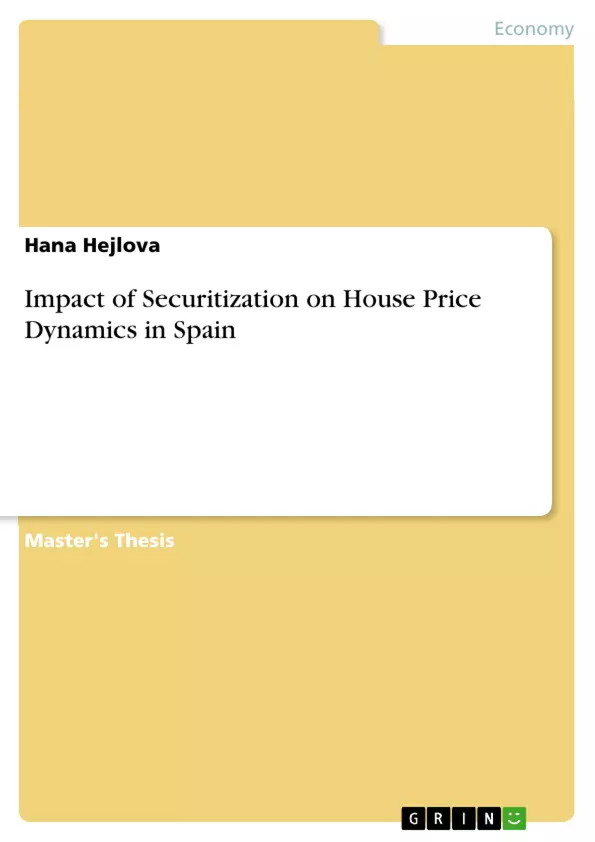The thesis tries to explain different nature of the dynamics during the upward and downward part of the last house price cycle in Spain, characterized by important rigidities. Covered bonds are introduced as an instrument which may accelerate a house price boom, while it may also serve as a source of correction to overvalued house prices in downturn. In a serious economic stress, lack of investment opportunities motivates investors to buy the covered bonds due to the strong guarantees provided, which may in turn help to revitalize the credit and housing markets.
To address such regime shift, house price dynamics is modelled within a framework of mutually related house price, credit and business cycles using smooth transition vector autoregressive model. Linear behaviour of such system is rejected, indicating the need to model house prices in a nonlinear framework. Also, importance of modelling house prices in the context of credit and business cycles is confirmed. Possible causality from issuance of covered bonds to house price dynamics was identified in this nonlinear structure.
Finally, potential threat to financial stability resulting from rising asset encumbrance both in the upward and downward part of the house price cycle was identified, stressing the need to model impact of the covered bonds on house prices in a situation when Basel III liquidity requirements motivate towards use of this instrument.
Inhaltsverzeichnis (Table of Contents)
- Introduction
- House price dynamics and financial crisis in Spain
- House prices in the context of real economy and financial system
- Determinants of house prices: Literature review
- Why house prices in Spain did not drop more significantly?
- Role of securitization in house price dynamics: Motivation
- Covered bonds and their link to house price dynamics
- What is covered bonds
- Definition
- Characteristics
- Supply and demand for covered bonds
- Legal foundation and classification
- Markets with covered bonds
- Differences between CB, non-secured debt and MBS
- C´edulas Hipotecarias and mortgage financing in Spain
- Behaviour of the covered bond markets under stress
- Dynamics of covered bonds and implications for financial stability
- Relationship between covered bonds and housing market
- Data analysis: Spain
- Data analysis: Selected countries
- What is covered bonds
- Empirical analysis
- Motivation
- Introduction to nonlinear modelling
- Options for ST(V)AR models and its empirical practice
- Suggested approach to modelling using STVAR models
- Empirical model of house price dynamics and covered bonds
- Approach
- Data
- Models
- Results
- The impact of covered bonds on house price dynamics in both upward and downward phases of the cycle
- The role of covered bonds in a framework of mutually related house price, credit, and business cycles
- The potential financial stability risks associated with the use of covered bonds in a context of rising asset encumbrance
- The implications of the Basel III liquidity requirements for the use of covered bonds and their potential impact on house prices
- The application of smooth transition vector autoregressive (STVAR) models to analyze nonlinear relationships in house price dynamics
- The Introduction provides an overview of the research topic, highlighting the importance of understanding house price dynamics in Spain during the last financial crisis. The paper argues that the widespread use of covered bonds may offer a unique explanation for the differences in house price adjustment observed in various countries.
- Chapter 2 delves into the dynamics of house prices in Spain in the context of the real economy and financial system. It examines the interaction between business, credit, and house price cycles, highlighting the potential for procyclicality and financial instability. It discusses various determinants of house price dynamics, including income, interest rates, and lending conditions, and explores the role of prudential regulation.
- Chapter 3 provides a detailed overview of covered bonds (CBs), their characteristics, and their differences from other forms of secured debt and asset-backed securities. The chapter explores the supply and demand for CBs, highlighting their role in attracting conservative investors and providing a source of cheap and liquid financing. The chapter then examines the specific features of CBs in Spain, including their legal framework, market structure, and their importance in mortgage financing.
- Chapter 4 delves into the empirical analysis of the relationship between covered bonds and house price dynamics. It examines the behavior of covered bond markets under stress, focusing on the financial and sovereign crises in the EU. The chapter analyzes the possible impact of covered bonds on financial stability, discussing potential procyclicality and risks associated with increasing asset encumbrance. It then examines the relationship between covered bonds and the housing market, exploring how they may contribute to house price bubbles and potentially facilitate a return to equilibrium during downturns.
Zielsetzung und Themenschwerpunkte (Objectives and Key Themes)
This thesis examines the distinct dynamics of house prices during the last house price cycle in Spain, particularly focusing on the differences between the upward and downward phases. The analysis aims to explain these dynamics in the context of significant household indebtedness and the widespread use of covered bonds for mortgage funding.
Zusammenfassung der Kapitel (Chapter Summaries)
Schlüsselwörter (Keywords)
This work focuses on the dynamics of house prices, the credit cycle, and the role of covered bonds in the Spanish housing market. Key themes include rigidities in the housing market, asymmetric house price behavior, the impact of securitization, and the potential implications of covered bonds for financial stability. The study employs smooth transition vector autoregressive models to investigate these relationships.
- Arbeit zitieren
- Hana Hejlova (Autor:in), 2014, Impact of Securitization on House Price Dynamics in Spain, München, GRIN Verlag, https://www.grin.com/document/312365



